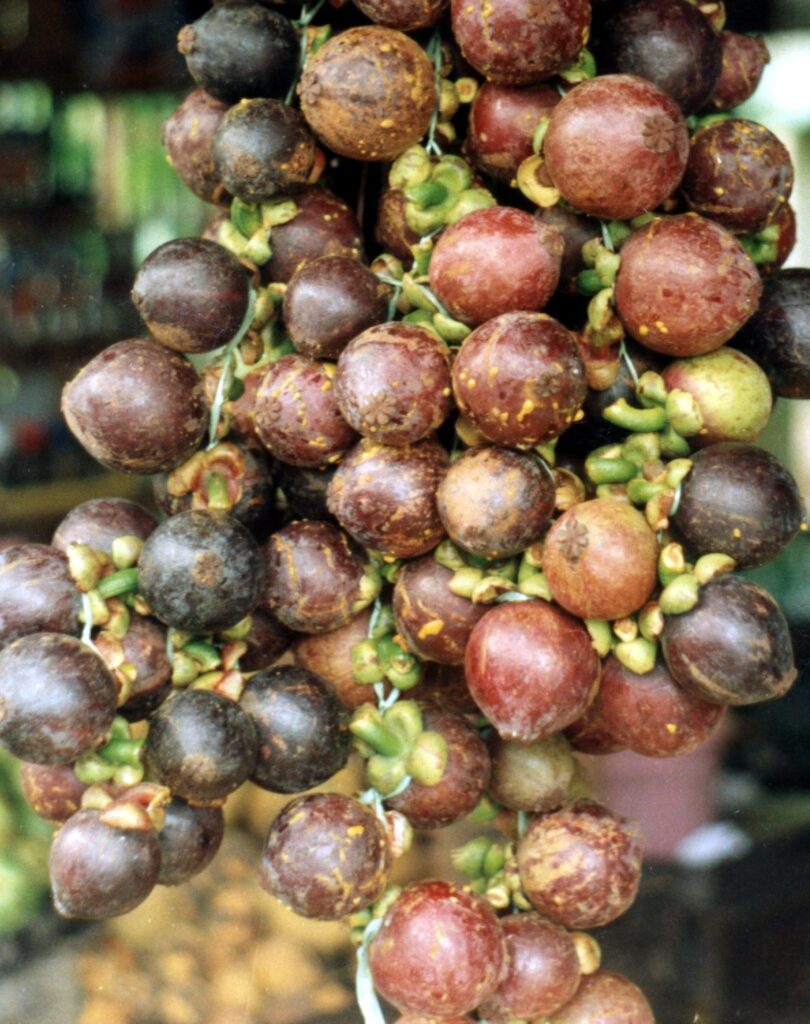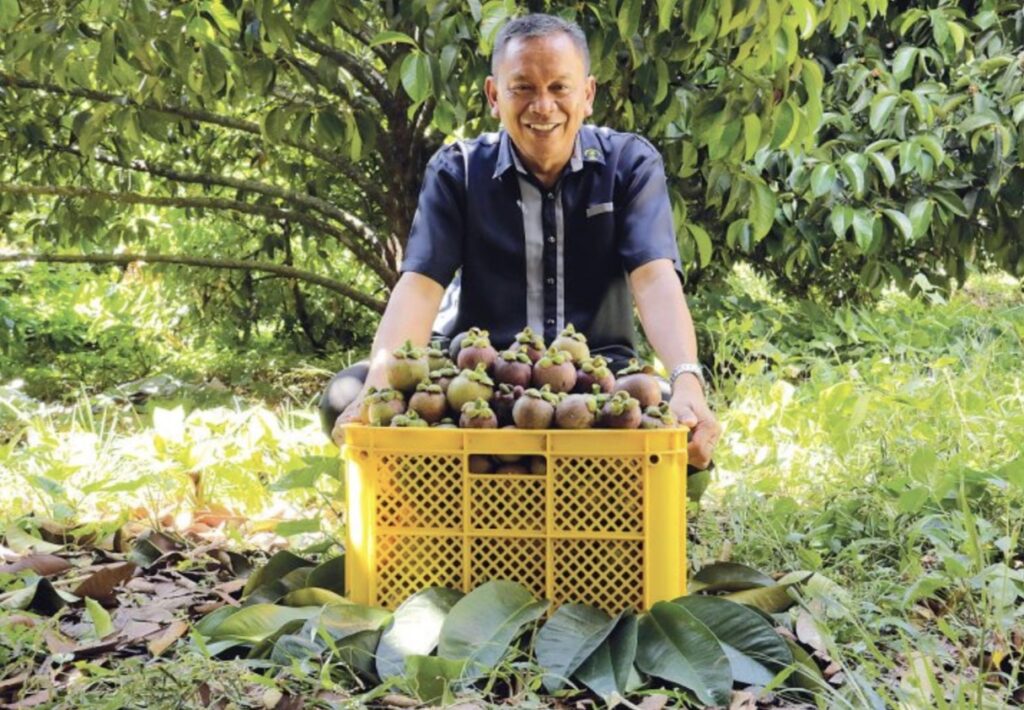Text and Photos by Henrylito D. Tacio
Additional Photo by Noel T. Provido
Before 1974, mangoes were available for a short period of time only, specifically during the summer months. But thanks to the chemical flower induction developed by Dr. Ramon C. Barba, mangoes can now be harvested throughout the year.
Today, the Philippines is one of the world’s mango exporters. In fact, it accounts for an average of 10% of the global fresh and dried mango exports. The major export destinations of once-neglected fruit are the United States, Hong Kong, South Korea, and Japan.
Now, there’s another breakthrough in the country’s fruit production. A Davao-based researcher has found the secret of producing off-season fruits of a crop that sounds like mango but is not actually a member of the Mangifera family.
Mangosteen, whose season is only from the months of August to October, can be harvested even during the time when it is not available. “Developing an off-season technology for mangosteen has the potential of bringing high profits to the farmers,” said Agapito Regulacion, the man who developed the technology, which was funded by the Bureau of Agricultural Research (BAR).
“With this technology, farmers can schedule the off-peak months wherein they can harvest mangosteen,” Regulacion, chief of the Davao Agricultural Research Central Experimental Station (DARCES) of the Davao regional field office of the Department of Agriculture (DA) in Manambulan, Tugbok District.
During the regular season, a kilo of mangosteen costs P25-P35 as the supply is plenty. But during the off-season, they are rarely available, and if people can find them, the price goes up to as high as P250-P300 per kilo.

Mangosteen cuttings 
Mangosteen
During the summer months, mangosteen is not available. The fruit is also in high demand during the Christmas season. Before the New Year arrives, mangosteen is one of the most sought-after fruits as people believe that its rounded-shape symbolizes money.
“If farmers are able to adopt and use this technology effectively, they can predict the schedule of their production and identify easily when to produce them the best, which is during off-season where the price of mangosteen is high,” Regulacion told the BAR Digest.
“If they can program their production and harvest them from December to February wherein mangosteen is not available, then it will be very profitable for them,” he added. “The price is 10 times more during the off-season.”
Aside from price, there is also a difference in the production. Based on the data at hand, Regulacion said that “season-produced mangosteen had more fruits with a yield of 58 kilos per tree while the off-season mangosteen had lesser yield of about 26 kilos per tree.”
It took several years for the off-season mangosteen technology to be successful. Regulacion conducted some studies on mangosteen, which can be grown from seeds or asexually through grafting. With funding from BAR, he started his study in January 2015 and ended four years later in January 2019.
Like mango, the flowering process is crucial in mangosteen production. “In the study, Regulacion used several research interventions to determine their efficacy in inducing fruit flowering in mangosteen,” wrote Rita T. Dela Cruz, author of the BAR Digest feature. “these included: pruning, plastic mulching, bark ringing, application of a chemical flower inducer, and installing rain shelter.”
In the BAR Digest feature, Regulacion shared the following information:
Pruning and plastic mulching: This involves cutting off one foot from the top of every lateral branch of the mangosteen tree, while plastic mulching involves installing 3.5 meters of UV plastic mulch at the base of the mangosteen trees.
Bark ringing: An established technology used for off-season rambutan in Thailand. It involves scraping the bark two feet from the base at one inch wide and on a cambium layer deep. The scraped part is covered with transparent plastic to avoid fungal contamination.
Chemical flower inducer application: The chemical flower inducer used is Paclobutrazol. It is applied at a rate of 500 parts per million (ppm) to five-week-old leaves (from flushing) and to fully mature leaves.
Rain shelter installation: A rain shelter (200 microns UV protected plastic sheet) is installed in a bamboo frame as a roofing material. Results of the study showed that this particular research intervention proved effective in inducing fruit flowering in mangosteen.
“It was observed that among the treatment tested, only the trees with rain shelter have induced flowering two months (60 days) after establishment. The other treatments have initiated leaf flushing,” Regulacion said.

He believed the high temperature and water stress caused the mangosteen trees to induce flowers.
“The microclimate inside the rain shelter was controlled resulting in a drought and higher temperature condition that triggered the trees to induce flowers after 60 days of stress period,” he pointed out. “During this period, carbohydrates begin to accumulate at the apical part of the leaves forcing the bud to break which then initiates the flowering process.”
Regulacion also established a trench canal lined with plastic to enhance drainage of rainwater and to avoid seepage. This, he said, is another important aspect of technology.
A farmer who invests in the off-season mangosteen technology needs P1 million. It may be costly, but the returns are high as the year progresses.
“A one-hectare mangosteen farm with a planting distance of 10 x 5 square meter will produce around 5 metric tons on its first year alone. It will have gross sales of P1,250,000 at P250/kilo (off-season price), thus a farmer will have an initial net income of P250,000 on the first year,” said a DA report.
In the first two years, a farmer gets an income of P1.5 million, but in the succeeding years, he has to spend P100,000 on replacing the bamboo frame as this has to be replaced every two years. The lifespan of the rain shelter is up to 5 years.
Aside from being profitable, the off-season mangosteen technology is environment-friendly. “Induced flowering through stress method minimizes the use of chemicals which does not only reduce operating cost but also promote sustainable farming,” Regulation said.
In the book Manual of Tropical and Subtropical Fruits, author Wilson Popenoe quoted David Fairchild, a fruit explorer, describing mangosteen in this manner: “This delicious fruit is about the size of a mandarin orange, round and slightly flattened at each end, with a smooth, thick rind, rich red-purple in color, with here and there a bright, hardened drop of the yellow juice which marks some injury to the rind when it was young.”
Mangosteen is usually eaten fresh as dessert. You need to hold the fruit with the stem-end downward. Take a sharp knife and cut around the middle completely through the rind, and lift off the top half. What you see are the fleshy segments exposed in the colorful “cup” – the bottom half of the rind. To eat it, lift out the segments by the fork.
Fairchild wrote: “(Mangosteens) are strikingly handsome as anything of the kind could well be, but it is only when the fruit is opened that its real beauty is seen.”
And it is only when the fruit is eaten that makes it one of the most delicious of its kind. “The taste of the mangosteen pulp much resembles that of a well-ripened plum, only it is so delicate that it melts in the mouth like a bit of ice cream,” Fairchild noted. “There is nothing to mar the perfection of this fruit, unless it be that the juice from the rind forms an indelible stain on a white napkin.”
Mangosteen is said to the queen of tropical fruits. British-born Malaysian author Desmond Tate has written these words in Tropical Fruit: “By popular acclaim, the mangosteen is held to be the most delectable of all the tropical fruits, and it has been proclaimed their queen. There is no doubt about the luxury of its taste. It has won unstinted praise down the ages from all who have encountered it.”
R. W. Apple Jr., writing for The New York Times, hailed: “No other fruit, for me, is so thrillingly, intoxicatingly luscious, so evocative of the exotic East, with so precise a balance of acid and sugar, as a ripe mangosteen. I thought so when I first tasted one half a lifetime ago, in Singapore, and I’ve thought so ever since. I’d rather eat one than a hot fudge sundae, which for a big Ohio boy is saying a lot.”

